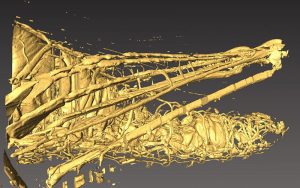
Researchers observed the fluid flow in the American bird grasshopper (Schistocerca americana) in real time to better understand how the insect’s open circulatory system is affected by the pull of gravity. (Photo by Tom Friedel/BirdPhotos.com via Wikimedia Commons)
PHOENIX – Insects spend a lot of time upside-down and sideways, but scientists know surprisingly little about how they react to the pull of gravity in these awkward positions.
Now, a study in the journal PNAS sheds new light on the topic.
An insect’s open circulatory system, which sloshes fluid known as hemolymph around the body cavity instead of pumping it through blood vessels, should make it more vulnerable to gravity’s tug.
“That was something I’ve kind of always wondered but never had any way to study it,” said lead author Jon Harrison of Arizona State University’s School of Life Sciences.
But when Harrison and colleagues observed fluid flow in the American bird grasshopper (Schistocerca americana), which is commonly used in research, they began to question this simple depiction.

A 3-D microtomographic image of a dead grasshopper in a head-down position shows inflated air sacs in the insect’s abdomen. Analysis showed the grasshopper’s tracheal respiratory system responds dramatically to its body position. (Photo courtesy of Socha Lab at Virginia Tech)
“We started flipping them upside down, right-side up and really being able to just see – in real time, in front of us – the effect of the blood moving and compressing whatever part of the grasshopper was down,” Harrison said.
Synchrotron X-ray imaging, radioactive tracing and micropressure measurements revealed evidence of internal valves that help maintain fluid pressure in parts of the grasshopper’s body.
“The fact that we can measure different pressures that aren’t coincident in different parts of the grasshopper tells us that there has to be some kind of functional valving, even though people haven’t been able to go in and find it,” Harrison said.
Although hemolymph is a bit player in distributing oxygen in a grasshopper’s body – that task is handled by a network of air sacs and tracheal tubes – it does bathe the insect’s tissues in vital water, ions, nutrients and hormones.
The researchers also found that grasshopper heartbeat rates sped up and slowed down in response to body position, much like vertebrates. Body position also affected the insect’s respiratory system.
Gravity is one of the most ubiquitous environmental effects on living systems, so the findings could have important implications for molecular biology, which makes wide use of the insects as lab models of biological processes.
But researchers also suspect the systems they’ve observed in grasshoppers might occur widely in invertebrates. If so, the possibility that responses to gravity might evolve early in cardiovascular systems and exist across a wide array of animals also could have notable repercussions for evolutionary biology.